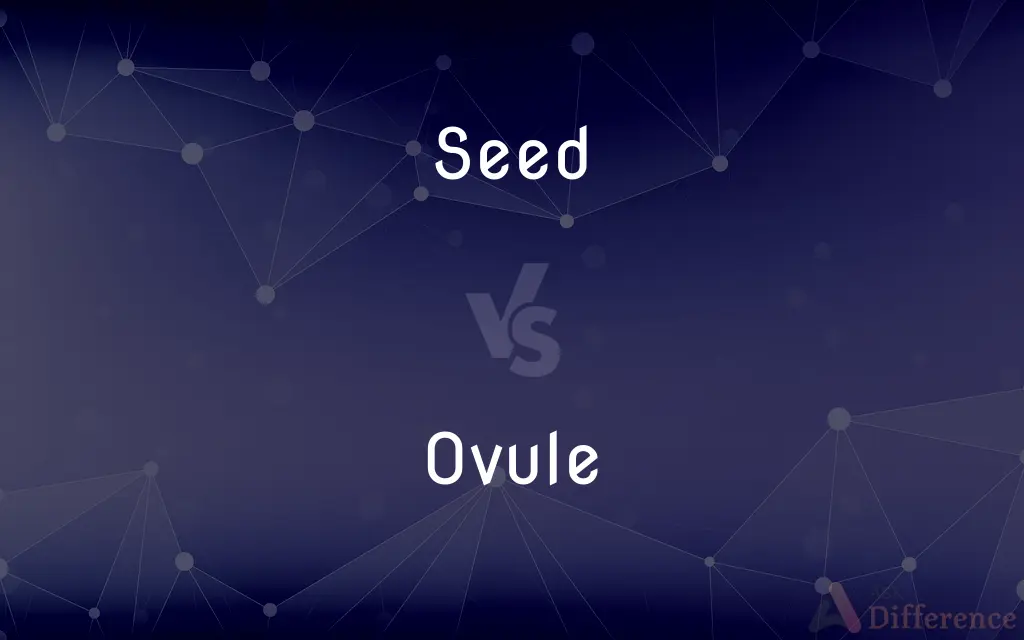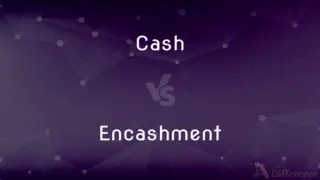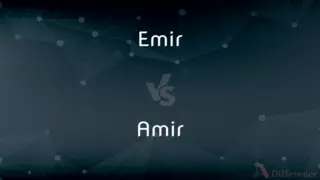Seed vs. Ovule — What's the Difference?
By Fiza Rafique & Maham Liaqat — Updated on March 11, 2024
Seeds and ovules are key components in plant reproduction, with the ovule being the structure that develops into a seed after fertilization.

Difference Between Seed and Ovule
Table of Contents
ADVERTISEMENT
Key Differences
A seed is a mature ovule that contains an embryonic plant, food reserves, and is enclosed within a protective seed coat. It is the final product of the sexual reproduction in plants, capable of developing into a new plant under appropriate conditions. An ovule, on the other hand, is a small structure within the ovary of a seed plant. It contains the female gametophyte where fertilization occurs and is the precursor to a seed. Before fertilization, the ovule consists of a protective layer called the integument, a nucellus, and the embryo sac that contains the egg cell.
The relationship between seeds and ovules is integral to understanding plant reproduction. The ovule serves as the initial stage in the development of a seed, housing the gametophyte generation where fertilization and the early stages of embryogenesis take place. After fertilization, the ovule undergoes significant changes, including the development of the seed coat and the accumulation of food reserves, culminating in the formation of a seed.
One of the key differences between seeds and ovules is their role in plant reproduction. The ovule is involved in the process leading up to fertilization, while the seed is the result of this process, playing a crucial role in the dissemination and germination of new plants. The seed's ability to remain dormant under unfavorable conditions until the environment is suitable for germination is another distinctive feature, setting it apart from the more vulnerable ovule.
Understanding the distinction between seeds and ovules is essential for grasping the fundamentals of plant biology and reproduction. While the ovule is the site of fertilization and early development, the seed represents the next generation of plants, equipped with the necessary resources and protection to ensure successful germination and growth.
Comparison Chart
Definition
A mature fertilized ovule containing an embryonic plant, food reserves, and a protective coat.
A small structure in the ovary of a seed plant containing the female gametophyte.
ADVERTISEMENT
Role in Reproduction
Final product of sexual reproduction, capable of developing into a new plant.
Precursor to a seed, houses the female gametophyte for fertilization.
Components
Embryo, food reserves (endosperm or cotyledons), and seed coat.
Integument, nucellus, and embryo sac with the egg cell.
Stage of Development
Post-fertilization, contains a developed embryo ready for germination.
Pre-fertilization, involved in the development and fertilization processes.
Function in Plant Lifecycle
Dissemination and germination to produce new plants.
Facilitates fertilization and the initial stages of seed development.
Compare with Definitions
Seed
A seed is the mature form of an ovule, containing an embryonic plant and necessary nutrients.
The gardener planted seeds in the hope of growing a vibrant array of flowers.
Ovule
An ovule contains the structures necessary for fertilization and initial seed development.
Within the flower's ovary, the ovules awaited fertilization to begin their transformation.
Seed
The protective coat of a seed shields the embryo and reserves from environmental factors.
The tough seed coat protects the delicate embryo from the harsh outside world.
Ovule
Ovules are encased within the ovary of a plant, where they develop until fertilization.
The plant's ovary swelled, full of ovules ready to be fertilized by incoming pollen.
Seed
The dispersal mechanisms of seeds vary widely, aiding in the spread of plant species.
Wind-dispersed seeds, like those of the dandelion, travel far from their parent plant.
Ovule
The integument of an ovule develops into the seed coat after fertilization.
The ovule's integument thickened, forming the protective layer for the developing seed.
Seed
Seeds serve as the primary means of reproduction for many plants, facilitating new plant growth.
Each seed carries the potential to sprout into a new plant under the right conditions.
Ovule
Ovules are attached to the placenta of the ovary via a structure called the funiculus.
Each ovule was connected to the ovary's placenta by a slender funiculus, ensuring its nourishment.
Seed
Seeds can remain dormant for extended periods until conditions are favorable for germination.
The seeds lay dormant through the winter, waiting for the warmth of spring to awaken.
Ovule
The embryo sac within an ovule contains the egg cell, crucial for reproduction.
The embryo sac housed the egg cell, the key player in the plant's reproductive process.
Seed
A seed is an embryonic plant enclosed in a protective outer covering. The formation of the seed is part of the process of reproduction in seed plants, the spermatophytes, including the gymnosperm and angiosperm plants.
Ovule
In seed plants, the ovule is the structure that gives rise to and contains the female reproductive cells. It consists of three parts: the integument, forming its outer layer, the nucellus (or remnant of the megasporangium), and the female gametophyte (formed from a haploid megaspore) in its center.
Seed
A mature plant ovule containing an embryo.
Ovule
(Botany) A structure in seed plants that consists of the embryo sac surrounded by the nucellus and one or two integuments and that develops into a seed after it is fertilized.
Seed
A small dry fruit, spore, or other propagative plant part.
Ovule
(Zoology) A small or immature ovum.
Seed
Seeds considered as a group
A farmer buying seed.
Ovule
(botany) The structure in a plant that develops into a seed after fertilization; the megasporangium of a seed plant with its enclosing integuments.
Seed
The seed-bearing stage of a plant
The grass is in seed.
Ovule
(zoology) An immature ovum in mammals.
Seed
A larval shellfish or a hatchling fish
Released scallop seed in the bay.
Ovule
The rudiment of a seed. It grows from a placenta, and consists of a soft nucleus within two delicate coatings. The attached base of the ovule is the hilum, the coatings are united with the nucleus at the chalaza, and their minute orifice is the foramen.
Seed
An egg or cocoon of certain insects
Silkworm seed.
Ovule
A small body that contains the female germ cell of a plant; develops into a seed after fertilization
Seed
A tiny bubble in a piece of glass.
Ovule
A small or immature ovum
Seed
(Medicine) A form of a radioactive isotope that is used to localize and concentrate the amount of radiation administered to a body site, such as a tumor.
Seed
A source or beginning; a germ
The seed of an idea.
Seed
A small amount of material used to start a chemical reaction.
Seed
A small crystal used to start a crystallization process.
Seed
A cell that disperses, especially a cancer cell that spreads from a primary tumor to another location in the body.
Seed
Offspring; progeny.
Seed
Family stock; ancestry.
Seed
Sperm; semen.
Seed
(Sports) A player who has been seeded for a tournament, often at a given rank
A top seed.
Seed
To plant seeds in (land, for example); sow.
Seed
To plant (a crop, for example) as seeds in soil.
Seed
To remove the seeds from (fruit).
Seed
To furnish with something that grows or stimulates growth or development
A bioreactor seeded with bacteria.
Seed
To disperse to, as cancer cells
Organs seeded by circulating tumor cells.
Seed
To disperse or transfer (cancer cells, for example)
A needle biopsy that seeded cancer cells into adjacent tissue.
Seed stem cells onto collagen gels.
Seed
(Meteorology) To sprinkle (a cloud) with particles, as of silver iodide, in order to disperse it or to produce precipitation.
Seed
To arrange (the drawing for positions in a tournament) so that the more skilled contestants meet in the later rounds.
Seed
To rank (a contestant) in this way.
Seed
To help (a business, for example) in its early development.
Seed
To sow seed.
Seed
To pass into the seed-bearing stage.
Seed
(Medicine) To disperse and often multiply, as cancer cells.
Seed
Set aside for planting a new crop
Seed corn.
Seed potatoes.
Seed
Intended to help in early stages
Provided seed capital for a fledgling business.
Seed
A fertilized and ripened ovule, containing an embryonic plant.
Seed
(countable) Any small seed-like fruit.
If you plant a seed in the spring, you may have a pleasant surprise in the autumn.
Seed
Any propagative portion of a plant which may be sown, such as true seeds, seed-like fruits, tubers, or bulbs.
Seed
An amount of seeds that cannot be readily counted.
The entire field was covered with geese eating the freshly sown seed.
Seed
(countable) A fragment of coral.
Seed
(uncountable) Semen.
A man must use his seed to start and raise a family.
Seed
A precursor.
The seed of an idea
Which idea was the seed (idea)?
Seed
(countable) The initial state, condition or position of a changing, growing or developing process; the ultimate precursor in a defined chain of precursors.
Seed
(sports) The initial position of a competitor or team in a tournament. (seed position)
The team with the best regular season record receives the top seed in the conference tournament.
Seed
The competitor or team occupying a given seed. (seed position)
The rookie was a surprising top seed.
Seed
(cryptography) The initialization state of a pseudorandom number generator or similar system. (seed number)
If you use the same seed you will get exactly the same pattern of numbers.
Seed
Commercial message in a creative format placed on relevant sites on the Internet. (seed idea or seed message)
The latest seed has attracted a lot of users in our online community.
Seed
Offspring, descendants, progeny.
The seed of Abraham
Seed
Race; generation; birth.
Seed
A small bubble formed in imperfectly fused glass.
Seed
(transitive) To plant or sow an area with seeds.
I seeded my lawn with bluegrass.
Seed
(transitive) To cover thinly with something scattered; to ornament with seedlike decorations.
Seed
(transitive) To start; to provide, assign or determine the initial resources for, position of, state of.
A venture capitalist seeds young companies.
The tournament coordinator will seed the starting lineup with the best competitors from the qualifying round.
The programmer seeded fresh, uncorrupted data into the database before running unit tests.
Seed
To allocate a seeding to a competitor.
Seed
To leave (files) available for others to download through peer-to-peer file sharing protocols (e.g. BitTorrent).
Seed
(intransitive) To be qualified to compete, especially in a quarter-final, semi-final, or final.
The tennis player seeded into the quarters.
Seed
(intransitive) To produce seed.
Seed
(intransitive) To grow to maturity.
Seed
To ejaculate inside the penetratee during intercourse, especially in the rectum.
Seed
(dialectal) see
Seed
A ripened ovule, consisting of an embryo with one or more integuments, or coverings; as, an apple seed; a currant seed. By germination it produces a new plant.
And God said, Let the earth bring forth grass, the herb yielding seed, and the fruit tree yielding fruit after his kind, whose seed is in itself.
Seed
The generative fluid of the male; semen; sperm; - not used in the plural.
Seed
That from which anything springs; first principle; original; source; as, the seeds of virtue or vice.
Seed
The principle of production.
Praise of great acts he scatters as a seed,Which may the like in coming ages breed.
Seed
Progeny; offspring; children; descendants; as, the seed of Abraham; the seed of David.
Seed
Race; generation; birth.
Of mortal seed they were not held.
Seed
To sow seed.
Seed
To shed the seed.
Seed
To grow to maturity, and to produce seed.
Many interests have grown up, and seeded, and twisted their roots in the crevices of many wrongs.
Seed
To sprinkle with seed; to plant seeds in; to sow; as, to seed a field.
Seed
To cover thinly with something scattered; to ornament with seedlike decorations.
A sable mantle seeded with waking eyes.
Seed
A small hard fruit
Seed
A mature fertilized plant ovule consisting of an embryo and its food source and having a protective coat or testa
Seed
One of the outstanding players in a tournament
Seed
Anything that provides inspiration for later work
Seed
The thick white fluid containing spermatozoa that is ejaculated by the male genital tract
Seed
Go to seed; shed seeds;
The dandelions went to seed
Seed
Help (an enterprise) in its early stages of development by providing seed money
Seed
Bear seeds
Seed
Place (seeds) in or on the ground for future growth;
She sowed sunflower seeds
Seed
Distribute (players or teams) so that outstanding teams or players will not meet in the early rounds
Seed
Sprinkle with silver iodide particles to disperse and cause rain;
Seed clouds
Seed
Inoculate with microorganisms
Seed
Remove the seeds from;
Seed grapes
Common Curiosities
What are the main components of a seed?
A seed contains an embryo, food reserves, and a protective seed coat.
How does an ovule become a seed?
An ovule becomes a seed after fertilization, when the embryo develops and the ovule's structures transform to support the new plant.
How do seeds adapt to ensure their survival?
Seeds have various dispersal mechanisms and can remain dormant under unfavorable conditions to ensure survival and propagation.
What is the primary function of a seed in plant reproduction?
Seeds serve to disseminate and germinate, producing new plants and continuing the species' lifecycle.
Can a plant grow without seeds?
Some plants can reproduce asexually without seeds, but for many species, seeds are essential for reproduction.
What determines the size and shape of a seed?
The size and shape of a seed are influenced by its genetic makeup and the environmental conditions during development.
Are ovules visible to the naked eye?
Ovules are typically small and enclosed within the ovary, making them not readily visible without dissection.
What role does the ovule play before fertilization?
The ovule houses the female gametophyte, including the egg cell, preparing for fertilization.
What is the significance of the seed coat?
The seed coat protects the embryo and food reserves from environmental threats and desiccation.
Why is the ovule considered the precursor to a seed?
The ovule contains all the necessary structures for fertilization and initial development, making it the foundational stage of a seed.
Can all ovules develop into seeds?
Not all ovules develop into seeds; only those that are successfully fertilized and undergo the necessary transformations will mature.
What happens to an ovule if it's not fertilized?
An unfertilized ovule will eventually deteriorate and will not develop into a seed.
How does the environment affect seed germination?
Factors like temperature, moisture, and light can significantly impact a seed's ability to germinate and grow.
How do seeds contribute to plant diversity?
Seeds allow plants to spread to new areas, promoting genetic diversity and adaptation to various environments.
What are some common methods of seed dispersal?
Seeds can be dispersed through various means, including wind, water, animals, and mechanical forces.
Share Your Discovery

Previous Comparison
Cash vs. Encashment
Next Comparison
Emir vs. AmirAuthor Spotlight
Written by
Fiza RafiqueFiza Rafique is a skilled content writer at AskDifference.com, where she meticulously refines and enhances written pieces. Drawing from her vast editorial expertise, Fiza ensures clarity, accuracy, and precision in every article. Passionate about language, she continually seeks to elevate the quality of content for readers worldwide.
Co-written by
Maham Liaqat













































